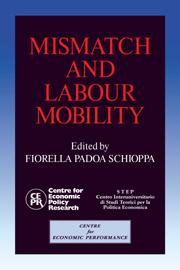Book contents
- Frontmatter
- Contents
- List of figures
- List of tables
- Preface
- Acknowledgements
- List of conference participants
- 1 A cross-country comparison of sectoral mismatch in the 1980s
- 2 Mismatch: a framework for thought
- Discussion
- 3 Match and mismatch on the German labour market
- Discussion
- 4 Mismatch in Japan
- Discussion
- 5 Mismatch and internal migration in Spain, 1962–86
- Discussion
- 6 Regional inequalities, migration and mismatch in Italy, 1960–86
- Discussion
- 7 Skill shortages and structural unemployment in Britain: a (mis)matching approach
- Discussion
- 8 Labour market tightness and the mismatch between demand and supply of less-educated young men in the United States in the 1980s
- Discussion
- 9 Skill mismatch, training systems and equilibrium unemployment: a comparative institutional analysis
- Discussion
- 10 Unemployment, vacancies and labour market programmes: Swedish evidence
- Discussion
- 11 Mismatch and labour mobility: some final remarks
- Index
Discussion
Published online by Cambridge University Press: 05 October 2010
- Frontmatter
- Contents
- List of figures
- List of tables
- Preface
- Acknowledgements
- List of conference participants
- 1 A cross-country comparison of sectoral mismatch in the 1980s
- 2 Mismatch: a framework for thought
- Discussion
- 3 Match and mismatch on the German labour market
- Discussion
- 4 Mismatch in Japan
- Discussion
- 5 Mismatch and internal migration in Spain, 1962–86
- Discussion
- 6 Regional inequalities, migration and mismatch in Italy, 1960–86
- Discussion
- 7 Skill shortages and structural unemployment in Britain: a (mis)matching approach
- Discussion
- 8 Labour market tightness and the mismatch between demand and supply of less-educated young men in the United States in the 1980s
- Discussion
- 9 Skill mismatch, training systems and equilibrium unemployment: a comparative institutional analysis
- Discussion
- 10 Unemployment, vacancies and labour market programmes: Swedish evidence
- Discussion
- 11 Mismatch and labour mobility: some final remarks
- Index
Summary
David Soskice's study highlights some interesting ideas on employment and training (ET) programmes and their effect on mismatch. I will begin by considering the structure of Soskice's presentation.
The first half of the study makes a methodological point. It suggests that, in an open economy framework, an effective ET programme may have an ambiguous influence on the level of skill mismatch of the economy. This because an effective ET programme, on the one hand, increases workers' skills, reducing mismatch but, on the other, may induce firms to move to product markets that require workers with higher skills, in this way increasing mismatch. In spite of this result, effective ET programmes have an uncontroversial negative effect on the equilibrium level of unemployment. Soskice suggests this last variable as the key indicator of the effectiveness of an ET programme.
The second part of the study presents an analysis of the interaction between the institutional structure of ET programmes and their effectiveness. Soskice's analysis suggests that ET programmes can be structured in two ways. Programmes may be offered by the government to prospective workers before their entrance in the job market, in the form of secondary or professional education. Alternatively, they may be offered by each firm according to its needs with some, or no, subsidies from the central authority.
- Type
- Chapter
- Information
- Mismatch and Labour Mobility , pp. 400 - 404Publisher: Cambridge University PressPrint publication year: 1991



